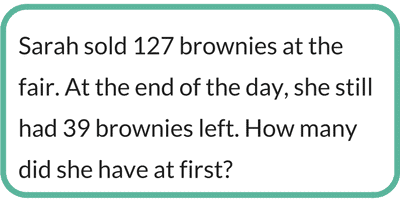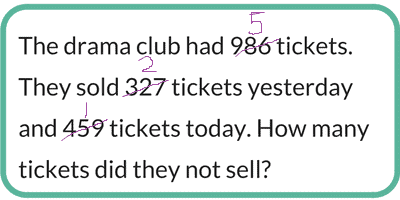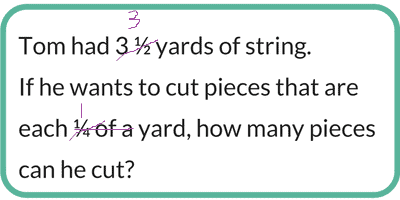 How to teach word problems, with 5 easy ways to help your children understand and solve word problems–and prevent that deer-in-the-headlights look!
How to teach word problems, with 5 easy ways to help your children understand and solve word problems–and prevent that deer-in-the-headlights look!
Your child is humming along on her math assignment, pencil flying over the page.
4 times 5? Got it!
6 times 7? Nailed it!
All is well. But then her pencil comes to a screeching halt. She’s gotten to the word problems.
In my experience, kids hardly ever freeze up on word problems because they can’t perform the calculations.
And it’s not because they can’t use math in real life. After all, if you give 3 children 7 doughnuts to share, I promise you that every child will end up with 2 and 1/3 doughnuts–even if none of them has ever solved a single fraction division problem!

Kids freeze up with word problems because they can’t decide which operation to use. “Do I add? Subtract? Multiply? Divide? Add then multiply? Subtract then divide? AAAHHH!”
Word problems feel very artificial to kids. They’re about people they don’t know, contexts they don’t care about, and situations they don’t understand. So, instead of using their common sense, kids just flail around, hoping that whatever operation they pick will be the right one.
The secret to helping kids solve word problems with confidence?
Make them more like real life.
Once kids see that word problems are just real-life problems written on a page, they’re able to use their everyday reasoning skills to make sense of word problems and solve them successfully. These five simple teaching strategies will make word problems come alive for your children so that they can tackle them with confidence.
1. Make your child the star
This is the easiest (and most fun) way to make word problems more relevant to kids: just change the names to people your child knows.
At my house, a lot of my daughter’s Singapore Math problems involve names she’s never heard of and that we’re not quite sure how to pronounce. Weilin? Meihua? I love the cross-cultural learning, but they make it hard for my daughter to focus on the math.
So, we just change the names to those of her and her brother.

With this one simple change, she can easily visualize the problem. Plus, she then enjoys figuring out that she saved $8 more than her brother.
2. Keep it real
Early elementary students (kindergartners, 1st graders, and 2nd graders) are very concrete thinkers. If your kids are this age, you have the opportunity to train them to think about word problems as real-life problems from the beginning.
To do this, model word problems with the actual items mentioned in the word problem.
If it’s about books, grab a stack of books.
If it’s about doughnuts, head to Krispy Crème (or get some pretend food from the toy kitchen).
And if it’s about live lobsters—well, feel free to use blocks or counters to stand for the lobsters instead.
Using hands-on manipulatives and real objects will help your primary-age children learn not to be intimidated by word problems. This will pay off as they begin to solve more complicated word problems in the upper elementary grades.
3. Lights, camera, action
As children progress through the elementary grades, it’s tedious and time-consuming to use counters to model problems with larger numbers. No one wants to count out 247 counters and then subtract 194 of them!
Instead, pantomime word problems to help them snap into focus. For example:

This is a hard problem! It only requires adding the two numbers together, but the structure of the problem makes it a challenge for kids to recognize it as addition. But when you act it out, the problem becomes much easier to understand.
First, pantomime selling plates of brownies and collecting money.
Then, pretend to look at the brownies still left on the table.
This simple drama will help your child visualize what is happening in the problem. Once he understands the sequence of events, it’s easier for him to understand that the question is asking about the number of brownies before any were sold. All he has to do is add 127 + 39 to find that Sarah had 166 at the beginning of the day.
4. As easy as 1, 2, 3
Sometimes, kids freeze up because the numbers in the problem simply look too BIG. They’re already worrying about the calculations that they’ll have to do, and so they don’t have any brain space left over to figure out what the problem is actually about.
To solve this, make the numbers in the problem easier. A lot easier. Lightly cross out the large numbers and substitute easy numbers like 1, 2, or 3 for them. Then, have your child think through the revised problem.

This problem is a lot less overwhelming now. Plus, you can now directly model it with counters if your child’s still not sure what to do.
Once your child has figured out how to solve the revised problem with the smaller numbers, help her translate her work to the larger numbers: “For your first step, you added the tickets sold yesterday to the tickets sold today. Now try it with the original numbers in the problem.”
5. Fractions and decimals
Changing the numbers also works well for older kids studying fractions and decimals.
For example, say your child is stuck on a problem like this:

Just change the fractions or decimals in the problem to whole numbers.

Now it’s easy to see that she should use division to solve the problem. Once she’s solved the simplified problem, she can go back to the original problem and use division to find the answer.
All of these teaching strategies have the same goal: making word problems come alive and feel relevant to your children. Use them to help your child use her common sense and reasoning skills to solve word problems with confidence–even when the doughnuts aren’t right in front of her!
Happy Math!



Great tips! I find that if I make every problem deal with pugs my 7yo can do them quickly. Go figure.
That’s hilarious! Love your podcast by the way. 🙂 I just started one.
Love it, Pam! Maybe ALL word problems should be mad libs style:
__(Your child’s name)___ had 17 ___(fill in the blank here with something your child likes to collect)…… If ___(person your child knows)____ gave you 4 more for your birthday, how many would you have then?
Oh my gosh! I see a really cool practice product in your future! Mad Lib math! <3
This was great. Thanks! We also use Singapore, and I’ve tried subbing in names of friends, which works very well. I’m excited to try the other tips.
This is a great article, Kate. We are about to up the ante on addition word problems. My problem is I use Right Start Math (and Addition/Subtraction Facts that Stick) and I like to go off script because I feel like RS is all over the map. How do I know I am writing word problems that are tricky enough? So far, I’ve had no tricks like the brownie example above. My problems sound something like, “There are 387 geese eating corn in the field. 93 more join them. How many geese are there now?” How important are the verbal tricks?
Thanks,
Kate
Hi Kate,
Different programs go to different levels of depth with word problem formats. Some kids really need a lot of very straight-forward problems to help them cement just the basic ideas. So, while it’s not essential that your children encounter every single kind of word problem, it is a good idea to vary the problems some to help them understand the operations more deeply. Here’s a couple ways to vary your addition and subtraction word problems to gradually help your kids go deeper with them:
1. Use both static and dynamic situations.
2. For dynamic situations, vary whether you ask about the starting point, the change, or the end result. For example, 2 other ways to phrase the bird problem are:
3. For subtraction, include comparison problems.
Happy Math!
Kate
Hi Kate,
Thank you for this article. It described my 1st grader to a T 🙂 Do you have any article on the dynamic and static situations you proposed above? We just completed the Singapore math assessments so we are diving into the program ASAP.
Regards,
Ada
Hi Ada,
I don’t have an article on it, but I do discuss it in-depth in my elementary arithmetic course at the Well-Trained Mind Academy. They’re offering it free right now, and it goes through the Singapore approach in-depth for whole-number arithmetic.
Happy Math!
Kate
I just clicked the link and cannot see the elementary arithmetic course being offered for free. Have I missed it?
Hi Maria,
The WTM Academy has been slammed with trying to get everyone registered for the fall, so their links are a little wonky right now. Try this link instead. As of this writing, the course shows up right at the top of the page.
Hope you enjoy the course, and happy math!
Kate
Great suggestions, Kate! Would love access to the steps in a print format to add to my word problem binder.
Mad Libs style math word problems is a great idea! 🙂
“Plus, she then enjoys figuring out that she saved $8 more than her brother.” This cracked me up. Definitely spoken from experience!
kate you are amazing! You are doing an intriguing thing. You are helping educators to help students to UNDERSTAND what they are going to be learning. You are using the trick “ “from known to the unknown”
Thank you so much for the word problem tips Kate! I hope these will help my son. He does very well in math but struggles with the word problems! I wish I would have ordered your 2nd grade curriculum last year. I looked into it, but chose a different one. My son did fine with it but it wasn’t our favorite. I am waiting for your 3rd grade release and am ordering it for next year! I looked at your sample student and teacher books and I’m really excited! Thank you!